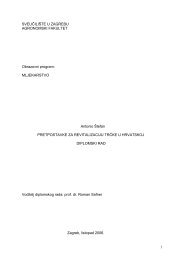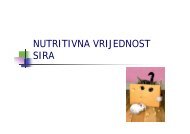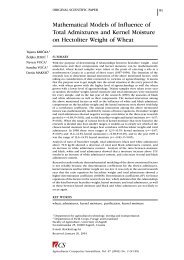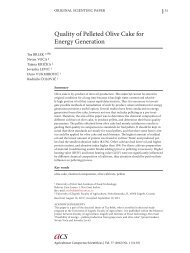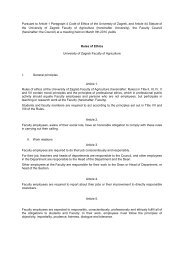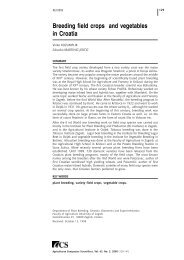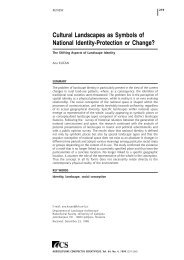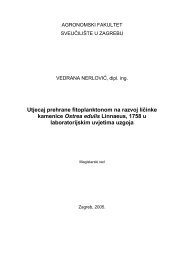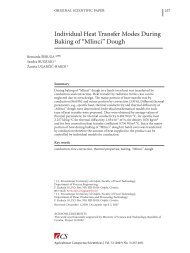Photo-mixotrophic Cultivation of Algae Euglena gracilis for Lipid ...
Photo-mixotrophic Cultivation of Algae Euglena gracilis for Lipid ...
Photo-mixotrophic Cultivation of Algae Euglena gracilis for Lipid ...
You also want an ePaper? Increase the reach of your titles
YUMPU automatically turns print PDFs into web optimized ePapers that Google loves.
<strong>Photo</strong>-<strong>mixotrophic</strong> <strong>Cultivation</strong> <strong>of</strong> <strong>Algae</strong> <strong>Euglena</strong> <strong>gracilis</strong> <strong>for</strong> <strong>Lipid</strong> Production67centrifugation (4500 rpm <strong>for</strong> 20 min). Sample solutions werefiltrated through a 0.20 μm filter be<strong>for</strong>e HPLC determination.CO 2 concentrations were measured in the bioreactor air inflowand outflow. CO 2 concentration measurements were per<strong>for</strong>medby infrared gas analyzers (Oxybaby ® V range, WITT-Gastechnik,Witten, Germany) every 12 hours.Cell number <strong>of</strong> E. <strong>gracilis</strong> in cultivation medium was determinedby counting under microscope (400 X magnification) inThoma chamber. Samples were continuously drawn from thestirred tank photo-bioreactor and after appropriate dilutionwith sterile water plated in the chamber.Results and discussionOptimization <strong>of</strong> medium composition <strong>for</strong> E. <strong>gracilis</strong>photo-heterotrophic cultivationDuring this investigation photo-heterotrophic cultivation <strong>of</strong>E. <strong>gracilis</strong> was per<strong>for</strong>med in order to increase biomass and lipidyield. There<strong>for</strong>e, different carbon sources (glucose, ethanol andacetic acid) and CSL were used <strong>for</strong> the modification <strong>of</strong> Hutnermedium composition. The CSL was used to replace glutamic,malic and succinic acids, glycine, asparagine and urea as wellas vitamins (B 1 and B 12 ) in order to simplify and reduce the cost<strong>of</strong> cultivation medium. In this investigation E. <strong>gracilis</strong> cultivationwas also done on the original Hutner medium as control.Results <strong>of</strong> these photo-heterotrophic cultivations are presentedin Table 1. As it can be seen in Table 1, the highest biomass yieldand cell density were observed by the cultivation on the originaland modified Hutner medium with glucose and CSL. Thiseffect can be explained by the fact that glucose is more favorablecarbon source compared to the ethanol and acetic acid due toenzyme induction and synthesis <strong>for</strong> glucose transport and metabolismin the algae cells (Yamane et al., 2001). However, thehighest lipid yield was observed during cultivation on the modifiedHutner medium with glucose and CSL what clearly showsthat this medium composition is suitable <strong>for</strong> lipid accumulationin algae E. <strong>gracilis</strong>. On the basis <strong>of</strong> these results it is also clearthat CSL is adequate complex source <strong>of</strong> carbon, nitrogen andgrowth factors (amino acids and vitamins) <strong>for</strong> E. <strong>gracilis</strong> cultivationand lipid production.In order to examine the effect <strong>of</strong> CSL concentration on thelipid yield during photo-heterotrophic cultivation <strong>of</strong> E. <strong>gracilis</strong>second set <strong>of</strong> experiments was carried out on modified Hutnermedium with glucose as a carbon source. In this research, CSLconcentration was changed in the range <strong>of</strong> 20 - 40 g/L and there<strong>for</strong>elipid yield was reduced as a consequence <strong>of</strong> the increase <strong>of</strong>easy metabolized nitrogen content in the medium (Table 2).It is well known that nitrogen depletion from the medium induceslipid accumulation (Evans and Ratledge, 1984; Yoon andRhee, 1983a; Yoon and Rhee, 1983b). In the nitrogen exhaustedmedium, glucose conversion in lipids is occurred due to presenthigh ATP:AMP ratio (Sheehan et al., 1998; Chen et al., 2011). Inthis investigation, cell number was at approximately constantlevel (0.22 - 0.24 · 10 8 cell/mL), but biomass and lipid yield werereduced with increase <strong>of</strong> CSL concentration in the medium.There<strong>for</strong>e, <strong>for</strong> further study modified Hutner medium with 20g/L <strong>of</strong> glucose and 20 g/L <strong>of</strong> CSL was selected (Table 2).Table 1. The effect <strong>of</strong> medium composition on the E. <strong>gracilis</strong>growth and lipid productionMediumCell number(10 8 cell/mL)Biomassyield (g/g)<strong>Lipid</strong> yield(g/g)Hutner medium 0.24 0.3 0.08MHM* (glucose and CSL) 0.22 0.24 0.20MHM* (ethanol and CSL) 0.15 0.09 0.10MHM* (acetic acid and CSL) 0.11 0.05 0.04*MHM - modified Hutner mediumTable 2. The effect <strong>of</strong> CSL concentration in the modifiedHutner medium on the E. <strong>gracilis</strong> growth and lipid productionCSL(g/L)Cell number(10 8 cell/mL)Biomass yield(g/g)<strong>Lipid</strong> yield(g/g)20 0.22 0.24 0.2030 0.23 0.15 0.1540 0.24 0.14 0.12Effect <strong>of</strong> bioreactor operational conditions on thephoto-heterotrophic cultivation <strong>of</strong> E. <strong>gracilis</strong> andlipid productionAt the start <strong>of</strong> research in the stirred tank photo-bioreactorthe effect <strong>of</strong> bioreactor operational parameters on the algaegrowth and lipid production was studied. Mixing intensity isimportant parameter <strong>of</strong> E. <strong>gracilis</strong> cultivation since it affects thecells and medium compounds distribution as well as mass andheat transfer. In algae large scale production optimal degree <strong>of</strong>turbulence is required due to the circulation <strong>of</strong> cells from thedark to the light zone <strong>of</strong> the bioreactor (Mata et al., 2010). On theother hand, high liquid velocities and degrees <strong>of</strong> turbulence (dueto mechanical mixing or air bubbles mixing) can damage algaecells because <strong>of</strong> high shear stress (Eriksen, 2008). The maximallevel <strong>of</strong> turbulence (above which cell death occurs) is strain dependentand it has to be experimentally determined in order toavoid decline in the bioprocess productivity (Mata et al., 2010).In order to increase the biomass and lipid production, E. <strong>gracilis</strong>photo-heterotrophic cultivation in the stirred tank photobioreactorwas carried out at various combinations <strong>of</strong> bioreactorstirrer speed and aeration rate and only a few characteristic combinationsare presented in Table 3. The cell number and biomassyield were increased with increase <strong>of</strong> stirrer speed and aerationrate due to the fact that cell growth is affected by the substrate(carbon source and oxygen) and light distribution as well as bythe shear stress in the photo-bioreactor. However, the highestlipid yield (0.25 g lipid / g cell dry weight) was observed withthe stirrer speed <strong>of</strong> 200 min -1 and aeration rate <strong>of</strong> 0.4 v/v min.Further increase <strong>of</strong> both bioreactor operational parameters wasrelated to the slight decrease <strong>of</strong> lipid yield as a consequence <strong>of</strong>shear stress enlargement in these conditions. However, in theseconditions biomass yield was also increased what resulted inapproximately similar lipid concentrations at the end <strong>of</strong> thesebioprocesses (Table 3). On the basis <strong>of</strong> these results it can be concludedthat <strong>for</strong> successful lipid production by E. <strong>gracilis</strong> aerationrate has to be in the range <strong>of</strong> 0.4 - 0.8 v/v min and stirrer speedAgric. conspec. sci. Vol. 78 (2013) No. 1
<strong>Photo</strong>-<strong>mixotrophic</strong> <strong>Cultivation</strong> <strong>of</strong> <strong>Algae</strong> <strong>Euglena</strong> <strong>gracilis</strong> <strong>for</strong> <strong>Lipid</strong> Production69Table 4. The effect <strong>of</strong> light source type on the E. <strong>gracilis</strong>growth and lipid production during photo-<strong>mixotrophic</strong>cultivation (8 days) in the stirred tank photo-bioreactorRunType <strong>of</strong> lightsourceCell number(10 8 cell/mL)Biomassyield (g/g)<strong>Lipid</strong> yield(g/g)1 aqua-glow lamps 0.28 0.25 0.172 sun-glo lamps 0.38 0.36 0.29concentration increases in the photo-bioreactor. There<strong>for</strong>e, duringphoto-autotrophic phase biomass concentration was reduced<strong>for</strong> 23.5%, but lipid concentration remains at approximatelyconstant level (3.70 - 4.03 g/L). At the same time, CO 2 in the airoutflow <strong>of</strong> photo-bioreactor was almost completely consumed,what clearly pointed out that it is used <strong>for</strong> biomass growth andlipid production (Figure 2.).Comparison between these two photo-<strong>mixotrophic</strong> cultivationson the basis <strong>of</strong> bioprocess efficiency parameters clearlyshows that considerably higher biomass and lipid yields as wellas cell number were observed during E. <strong>gracilis</strong> cultivation withsun-glo lumps (Table 4). This effect can be explained by thefact that during cultivation with sun-glo lumps CO 2 is moreefficiently used <strong>for</strong> biomass growth and lipid production (CO 2concentration in the air outflow was only 0.1%). There<strong>for</strong>e, it isclear that <strong>for</strong> photo-autotrophic cultivation <strong>of</strong> algae E. <strong>gracilis</strong>light source has to reproduce sun light in order to avoid significantreduction <strong>of</strong> biomass and lipid yields. Results obtained inthis research clearly indicate E. <strong>gracilis</strong> potential <strong>for</strong> photo-<strong>mixotrophic</strong>cultivation and lipid production. However, reduction<strong>of</strong> biomass yield during photo-autotrophic cultivation gives additionalchallenge <strong>for</strong> the further research <strong>of</strong> E. <strong>gracilis</strong> growthin these conditions.ConclusionsResults <strong>of</strong> this research clearly show that the photo-<strong>mixotrophic</strong>cultivation <strong>of</strong> E. <strong>gracilis</strong> <strong>for</strong> lipid production can besuccessfully carried out during two stage cultivation inside onestirred tank photo-bioreactor. Modification <strong>of</strong> Hutner mediumwas successfully done by the replacement <strong>of</strong> organic acids,amino-acids and vitamins (B 1 and B 12 ) with corn steep liquor(CSL) as complex source <strong>of</strong> these compounds. Modified Hutnermedium with 20 g/L <strong>of</strong> glucose and 20 g/L <strong>of</strong> CSL provided thehighest lipid content in E. <strong>gracilis</strong> cells and confirmed potential<strong>of</strong> CSL as alternative and low-cost medium compound <strong>for</strong>the E. <strong>gracilis</strong> cultivation. The lipid production <strong>of</strong> E. <strong>gracilis</strong> dependedhighly on the type <strong>of</strong> light source and CO 2 level in thebioreactor air inflow. During photo-<strong>mixotrophic</strong> cultivation <strong>of</strong>E. <strong>gracilis</strong> with sun-glo lamps and 2% CO 2 in the air inflow thelipid yield reached the highest level (0.29 g/g). However, in thisphoto-<strong>mixotrophic</strong> cultivation the reduction <strong>of</strong> biomass concentrationduring photo-autotrophic cultivation was also observedwhat requires further research in order to define optimal conditions<strong>for</strong> E. <strong>gracilis</strong> cultivation in these conditions.ReferencesBligh E. G., Dyer W. J. (1959). A rapid method <strong>of</strong> total lipid extractionand purification. Can J Biochem Physiol 37: 911-917Chen M., Tang H., Ma H., Holland T. C., Ng K. Y. S. Salley S. O.(2011). Effect <strong>of</strong> nutrients on growth and lipid accumulation inthe green algae Dunaliella tertiolecta. Bioresour Technol 102:1649-1655Chisti Y. (2007). Biodiesel from microalgae. Biotechnol Adv 25:294-306Demirbas A. (2009). Production <strong>of</strong> biodiesel from algae oils. EnergSources Part A 31: 163-168Eriksen N. T. (2008). The technology <strong>of</strong> microalgal culturing.Biotechnol Lett 30: 1525- 1536Evans C. T., Ratledge C. (1984). Effect <strong>of</strong> Nitrogen Source on <strong>Lipid</strong>Accumulation in Oleaginous Yeasts. J Gen Microbiol 130:1693-1705Hankamer B., Lehr F., Rupprecht J., Mussgnug J. H., Posten C.,Kruse O. (2007). <strong>Photo</strong>synthetic biomass and H 2 production bygreen algae: From bioengineering to bioreactor scale-up. PhysiolPlantarum 131: 10-21Hutner S.H., Provasoli L. (1951). The phyt<strong>of</strong>lagellates. In:Biochemistry and Physiology <strong>of</strong> Protozoa, Vol. 1 (A Lw<strong>of</strong>f eds.),Academic Press, New York, 27-35Mata T. M., Martins A. A., Caetano N. S. (2010). Microalgae <strong>for</strong>biodiesel production and other applications: A review. RenewSust Energ Rev 14: 217-232Ogbonna J. C. (1999). Tomiyama S., Tanaka H., Production <strong>of</strong> alphatocopherolby sequential heterotrophic-photoautotrophic cultivation<strong>of</strong> <strong>Euglena</strong> <strong>gracilis</strong>. J. Biotechnol 70: 213-221Rodolfi L., Chini-Zittelli G., Bassi N. Padovani G., Biondi N.,Bonini G., Tredici M. R. (2009). Microalgae <strong>for</strong> oil: strain selection,induction <strong>of</strong> lipid synthesis and outdoor mass cultivationin a low-cost photobioreactor. Biotechnol Bioeng 102: 100-112Šantek B., Felski M., Friehs K., Lotz M., Flaschel E. (2009).Productin <strong>of</strong> paramylon, a beta-1,3-glucan, by heterotrophiccultivation <strong>of</strong> <strong>Euglena</strong> <strong>gracilis</strong> on a synthetic medium. Eng LifeSci 9: 23-28Sheehan J., Dunahay T., Benemann J., Roessler P. (1998). A lookback at the U.S. Department <strong>of</strong> Energy’s Aquatic SpeciesProgram-biodiesel from alge http://www1.eere.energy.gov/biomass/pdfs/biodiesel_from_algae.pdfSpolaore P., Joannis-Cassan C., Duran E., Isambert A. (2006).Commercial applications <strong>of</strong> microalgae. J Biosci Bioeng 101:87-96Takeyama H., Kanamaru A., Yoshino Y., Kakuta H., KawamuraY., Matsunaga T. (1997). Production <strong>of</strong> Antioxidant Vitamins,β-Carotene, Vitamin C and Vitamin E, by the Two-StepCultured <strong>Euglena</strong> <strong>gracilis</strong> Z. Biotechnol Bioeng 53: 185-190Tsukahara K., Sawayama S. (2005). Liquid fuel production usingmicroalgae. J Jpn Petrol Inst 48: 251-259Ugwu C. U., Aoyagi H., Uchiyama H. (2008). <strong>Photo</strong>bioreactors <strong>for</strong>mass cultivation <strong>of</strong> algae. Bioresour Technol 99: 4021-4028Vergara-Fernandez A., Vargas G., Alarcon N., Velasco A. (2008).Evaluation <strong>of</strong> marine algae as a source <strong>of</strong> biogas in a two-stageanaerobic reactor system. Biomass Bioenerg 32: 338-344Yamane Y., Utsunomiya T., Watanabe M., Sasaki K. (2001). Biomassproduction in <strong>mixotrophic</strong> culture <strong>of</strong> <strong>Euglena</strong> <strong>gracilis</strong> underacidic condition and its growth energetics. Biotechnol Lett 23:1223-1228Yoon S. H., Rhee J. A. (1983a). Quantitative physiology <strong>of</strong>Rhodotorula glutinis <strong>for</strong> microbial lipid production. ProcessBiochem. 18: 2-4Yoon S. H., Rhee J. S. (1983b). <strong>Lipid</strong> from yeast fermentation: effects<strong>of</strong> cultural conditions on lipid production and its characteristics<strong>of</strong> Rhodotorula glutinis. J. Am. Oil Chem Soc 60: 1281-1286acs78_09Agric. conspec. sci. Vol. 78 (2013) No. 1




